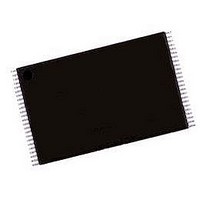AM29F032B-90EC Spansion Inc., AM29F032B-90EC Datasheet - Page 15

AM29F032B-90EC
Manufacturer Part Number
AM29F032B-90EC
Description
Flash Memory IC
Manufacturer
Spansion Inc.
Datasheets
1.AM29F032B-90EI.pdf
(39 pages)
2.AM29F032B-90EC.pdf
(39 pages)
3.AM29F032B-90EI.pdf
(39 pages)
Specifications of AM29F032B-90EC
Memory Size
32Mbit
Memory Configuration
4M X 8
Ic Interface Type
Parallel
Access Time
90ns
Memory Case Style
TSOP
No. Of Pins
40
Operating Temperature Range
0°C To +70°C
Termination Type
SMD
Lead Free Status / RoHS Status
Contains lead / RoHS non-compliant
Available stocks
Company
Part Number
Manufacturer
Quantity
Price
Company:
Part Number:
AM29F032B-90EC
Manufacturer:
SPANSION
Quantity:
1 200
Autoselect Command Sequence
The autoselect command sequence allows the host
system to access the manufacturer and devices codes,
and determine whether or not a sector is protected.
The Command Definitions table shows the address
and data requirements. This method is an alternative to
that shown in the Autoselect Codes (High Voltage
Method) table, which is intended for PROM program-
mers and requires V
The autoselect command sequence is initiated by
writing two unlock cycles, followed by the autoselect
command. The device then enters the autoselect
mode, and the system may read at any address any
number of times, without initiating another command
sequence.
A read cycle at address XX00h retrieves the manufac-
turer code. A read cycle at address XX01h returns the
device code. A read cycle containing a sector address
(SA) and the address 02h in returns 01h if that sector
is protected, or 00h if it is unprotected. Refer to the
Sector Address tables for valid sector addresses.
The system must write the reset command to exit the
autoselect mode and return to reading array data.
Byte Program Command Sequence
Programming is a four-bus-cycle operation. The pro-
gram command sequence is initiated by writing two un-
lock write cycles, followed by the program set-up
command. The program address and data are written
next, which in turn initiate the Embedded Program al-
gorithm. The system is not required to provide further
controls or timings. The device automatically provides
internally generated program pulses and verify the pro-
grammed cell margin. The Command Definitions take
shows the address and data requirements for the byte
program command sequence.
When the Embedded Program algorithm is complete,
the device then returns to reading array data and ad-
dresses are no longer latched. The system can deter-
mine the status of the program operation by using DQ7,
DQ6, or RY/BY#. See “Write Operation Status” for in-
formation on these status bits.
Any commands written to the device during the Em-
bedded Program Algorithm are ignored. Note that a
14
ID
on address bit A9.
Am29F032B
hardware reset immediately terminates the program-
ming operation. The program command sequence
should be reinitiated once the device has reset to read-
ing array data, to ensure data integrity.
Programming is allowed in any sequence and across
sector boundaries. A bit cannot be programmed
from a “0” back to a “1”. Attempting to do so may
halt the operation and set DQ5 to “1”, or cause the
Data# Polling algorithm to indicate the operation was
successful. However, a succeeding read will show that
the data is still “0”. Only erase operations can convert
a “0” to a “1”.
Chip Erase Command Sequence
Chip erase is a six-bus-cycle operation. The chip erase
command sequence is initiated by writing two unlock
cycles, followed by a set-up command. Two additional
unlock write cycles are then followed by the chip erase
command, which in turn invokes the Embedded Erase
algorithm. The device does not require the system to
preprogram prior to erase. The Embedded Erase algo-
rithm automatically preprograms and verifies the entire
memory for an all zero data pattern prior to electrical
erase. The system is not required to provide any con-
trols or timings during these operations. The Command
Definitions table shows the address and data require-
ments for the chip erase command sequence.
Any commands written to the chip during the Embed-
ded Erase algorithm are ignored. Note that a hardware
reset during the chip erase operation immediately ter-
minates the operation. The Chip Erase command se-
quence should be reinitiated once the device has
returned to reading array data, to ensure data integrity.
The system can determine the status of the erase
operation by using DQ7, DQ6, DQ2, or RY/BY#. See
“The Erase Resume command is valid only during
the Erase Suspend mode.” for information on these
status bits. When the Embedded Erase algorithm is
complete, the device returns to reading array data
and addresses are no longer latched.
Figure 3 illustrates the algorithm for the erase opera-
tion. See the Erase/Program Operations tables in “AC
Characteristics” for parameters, and to the Chip/Sector
Erase Operation Timings for timing waveforms.

















